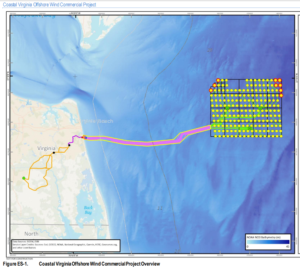
by Steve Haner
Dominion Energy Virginia’s first wave of offshore wind remains on schedule, and within the announced capital cost of $9.8 billion; and the cost per unit of the energy from the turbines will be lower than initially projected, the utility reported last week.
Details? Well, many of those are secrets. Much of the brief report the utility filed with State Corporation Commission remains redacted, with large blocks covered by black ink. The redacted data involves reports from an affiliate corporation, Blue Ocean Energy Marine LLC. There apparently is also another document “filed under seal under separate cover.”
Finally, Dominion refers to an Excel file that includes all the data on the new levelized cost of energy (LCOE) calculations which was posted to a shared eRoom. The password is available only to the SCC and case parties who signed non-disclosure agreements, reports the SCC’s communications director in response to a query about access for Bacon’s Rebellion.
Among the interesting items which are on the record:
The next big permitting hurdle is the final environmental impact statement (EIS), which Dominion expects will be delivered by the Bureau of Ocean Energy Management at the end of September. A draft EIS was published in late 2022 and was followed by a vigorous comment period. The issues raised by the comments are supposed to be addressed in the final version.
That should be followed by a formal record of decision from BOEM (approving it all, of course) and it is at that point that any lawsuit that comes will appear. The record of decision is what gets haled before a judge if a person or group is challenging the project. If the application is denied, of course, Dominion could appeal. Suits are already pending against earlier BOEM records of decision (Vineyard Wind and South Fork Wind, to name two.)
The final permit being awaited is from the Army Corps of Engineers, which Dominion expects by the end of January 2024. Then, it wrote:
Onshore and offshore construction will commence shortly after the receipt of the final permits. The updated milestone schedule dates are not expected to impact the planned project in-service during late 2026.
Key to the construction schedule is the American-built and flagged installation vessel Dominion is helping to pay for, with the fascinating choice of name Charybdis. (Is a sister ship called Scylla next?) Some of that information is deemed too secret for the bill-paying public to know, but the final bullet point states the ship will be in operation next year.
Likewise, information is hidden about two “charter parties,” which likely refers to the mass shipment of turbine generator components from European or Asian manufacturers in chartered merchant vessels. The term “charter party” is used in international trade. With all the details blocked out, little is clear about those “charter parties.”
The drop in the levelized cost of energy claimed is from the $87 per megawatt-hour cited in the application down to $80 per megawatt-hour. Those are in 2027 dollars. That works out to 8 cents per kilowatt-hour. (Generation costs are only one element of the customer bill, remember.)
One reason for the change mentioned is that Dominion now intends to claim a federal production tax credit (PTC) on the windfarm’s output, rather than a federal investment tax credit (ITC) on its capital costs. Both are allowed and both were apparently sweetened by the “Inflation Reduction Act” altering the renewable incentives, but now the PTC is Dominion’s preferred approach.
Dominion also claims that the renewable energy credits available to the company from power produced will have higher values than it first projected, $9.70 per MWH rather than $8.20. Absent the REC values (and if Dominion uses the power internally, it gets no such payment), the LCOE rises to $89.60 per MWH, or closer to 9 cents per KWH.
All of that is still based upon the assumed 42% capacity factor, i.e. that the turbines will produce electricity on average 42% of the time. The cost per unit of energy slides up or down with what actually happens with that output in the coming decades.
The math on all this is complicated. Some time with the Excel spreadsheet would be helpful. One can hope the rules will loosen someday or the utility will decide to share.

Leave a Reply
You must be logged in to post a comment.